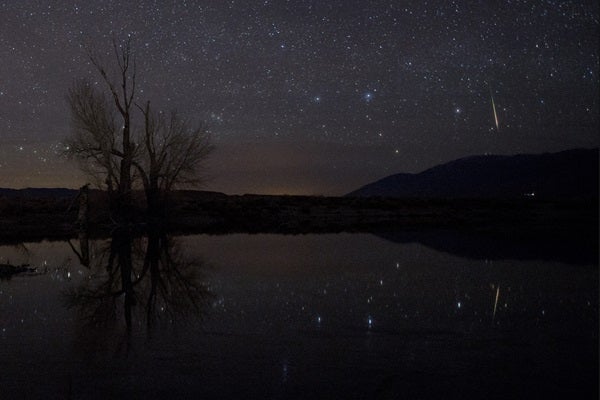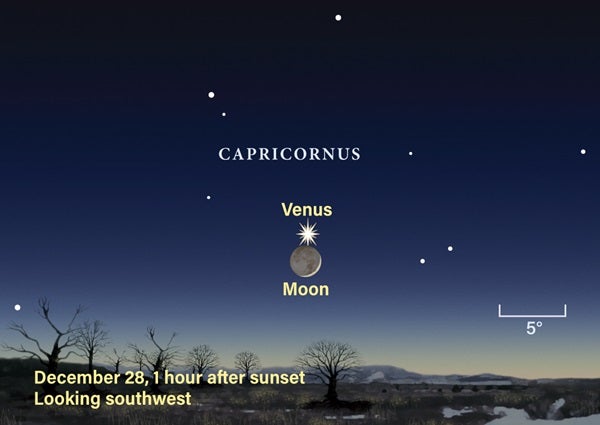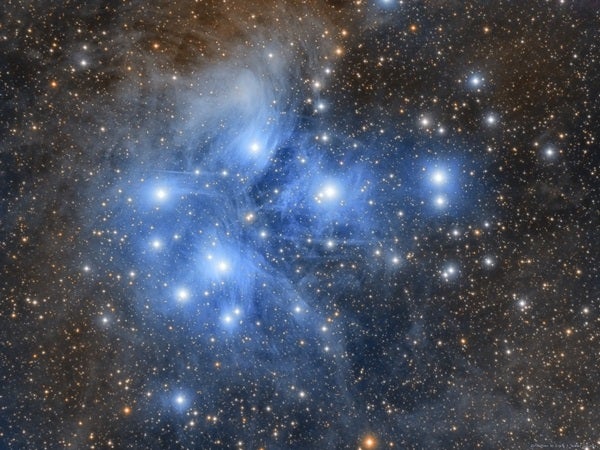The variable star Algol in Perseus reaches minimum brightness around 8:51 p.m. EST, when it shines at magnitude 3.4. If you start watching it after darkness falls, you can see it more than triple in brightness, to magnitude 2.1, over the course of about five hours. This eclipsing binary star runs through a cycle from minimum to maximum and back every 2.87 days. Algol appears in the eastern sky after sunset and passes nearly overhead around 9 p.m. local time.
Jupiter passes behind the Sun from our perspective, a configuration astronomers call conjunction, at 1 p.m. EST. Needless to say, our star’s glare makes it impossible to see the planet. Jupiter will return to view before dawn in mid-January.
Although the Moon passed between the Sun and Earth just two days ago, its rapid orbital motion has already brought it back into view in the southwestern sky after sunset. As a bonus, magnitude –3.9 Venus appears just 2° above Luna’s slender crescent. The two brightest objects in the night sky make a stunning pair from early twilight until they set shortly after 7 p.m. local time. Of course, both objects are worth viewing through a telescope as well. The Moon shows exquisite detail along its terminator — the curved line that separates the sunlit and dark portions of the surface. And Venus displays a 13″-diameter disk that appears 83 percent lit.
Sunday, December 29
The final week of the year offers an exceptional chance to spot the 10th-largest member of the asteroid belt, a collection of at least several hundred thousand objects that lies between the orbits of Mars and Jupiter. Asteroid 15 Eunomia is sliding through the conspicuous Water Jar asterism in the constellation Aquarius. This group of 4th- and 5th-magnitude stars, which comprises Gamma (γ), Pi (π), Zeta (ζ), and Eta (η) Aquarii, lies nearly 20° southwest of the southwestern corner of the Great Square of Pegasus. Eunomia currently glows at 10th magnitude, so you’ll need a small telescope to pick it up.
Monday, December 30
As winter tightens its grip on the Northern Hemisphere during the year’s final week, one of the most familiar constellations takes center stage. Orion the Hunter appears conspicuous in the eastern sky as twilight fades and grows even more prominent after darkness settles in. The star group climbs highest in the south around 11 p.m. local time, when it stands about halfway to the zenith from mid-northern latitudes.
Tuesday, December 31
For those who recently caught the observing bug, the so-called Summer Triangle must seem like a huge misnomer. That’s because this asterism remains on view after darkness falls in late December. Look for Vega, the fifth-brightest star in the sky and the brightest triangle member, in the northwest after nightfall. Deneb lies above Vega and about halfway to the zenith. Deneb marks the top of another asterism, the Northern Cross, which stands nearly straight up from the horizon on December evenings. Altair, the third triangle member, appears due west and near the same altitude as Vega. The trio remains on view until Altair sets around 8 p.m. local time.
Wednesday, January 1
Ruddy Mars grows more prominent before dawn with each passing week. The Red Planet now rises before 4:30 a.m. local time and climbs 20° above the southeastern horizon an hour before sunrise. Mars glows at magnitude 1.6, which is a full magnitude brighter than any of the background stars belonging to its host constellation, Libra the Scales. Unfortunately, a telescope doesn’t add much to the view, revealing a bland disk only 4″ across.
The Moon reaches apogee, the farthest point in its orbit around Earth, at 8:30 p.m. EST. It then lies 251,394 miles (404,580 kilometers) from Earth’s center.
Thursday, January 2
First Quarter Moon arrives at 11:45 p.m. EST. Our satellite rises in the east around noon local time but doesn’t become prominent until the Sun sets a little before 5 p.m. By 6 p.m., it appears due south and about halfway to the zenith. The Moon’s half-lit orb then lies among the background stars of Cetus the Whale.
Two of the finest deep-sky objects shine prominently on evenings in early January. The Pleiades and Hyades star clusters climb highest in the south during midevening but remain conspicuous nearly the whole night. The Pleiades, also known at the Seven Sisters and M45, appears like a small dipper to the naked eye. The larger Hyades forms the V-shaped head of Taurus the Bull. Although both look nice with the naked eye, binoculars show them best.
Saturday, January 4
The Quadrantid meteor shower reaches its peak this morning. The slightly gibbous Moon sets around 1 a.m. local time, leaving nearly five hours of darkness for watching. The Quadrantid shower typically produces up to 120 meteors per hour, an average of two per minute, so observers should be in for a great show if the weather cooperates. The meteors appear to radiate from a spot in the northern part of the constellation Boötes — an area once occupied by the now-defunct constellation Quadrans Muralis — a region that climbs highest just before dawn.
Sunday, January 5
Earth reaches perihelion, the closest point to the Sun during its year-long orbit, at 3 a.m. EST. The two then lie 91.4 million miles (147.1 million kilometers) apart. It surprises many people to learn that Earth comes closest to the Sun in the dead of winter, but the cold weather in the Northern Hemisphere at this time of year arises because the Sun lies low in the sky.
The Sun is in the news more than once today. Although people in the Northern Hemisphere experienced the shortest day of the year two weeks ago (at the winter solstice December 21), the Sun has continued to rise slightly later with each passing day. That trend stops this morning for those at 40° north latitude. Tomorrow’s sunrise will arrive a second earlier than today’s. This turnover point depends on latitude. If you live farther north, the switch occurred a few days ago; closer to the equator, the change won’t happen until later this month.












